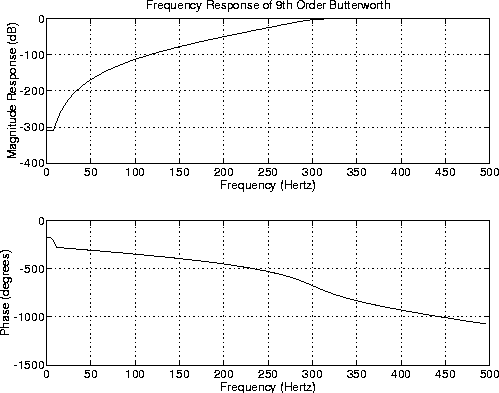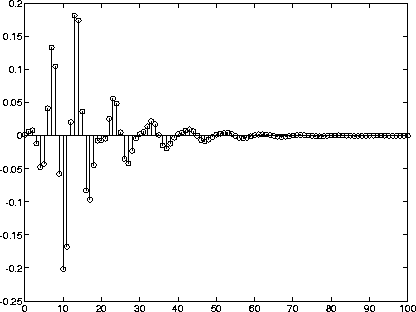high for a highpass digital filter with cutoff frequency Wn
stop for an order 2*n bandstop digital filter if Wn is a two-element vector, Wn = [w1 w2]
The stopband is w1 <  <
< w2.
| Signal Processing Toolbox | Help Desk |
[b,a] = butter(n,Wn) [b,a] = butter(n,Wn,'ftype') [b,a] = butter(n,Wn,'s') [b,a] = butter(n,Wn,'ftype','s') [z,p,k] = butter(...) [A,B,C,D] = butter(...)
butter designs lowpass, bandpass, highpass, and bandstop digital and analog Butterworth filters. Butterworth filters are characterized by a magnitude response that is maximally flat in the passband and monotonic overall.
Butterworth filters sacrifice rolloff steepness for monotonicity in the pass- and stopbands. Unless the smoothness of the Butterworth filter is needed, an elliptic or Chebyshev filter can generally provide steeper rolloff characteristics with a lower filter order.
[b,a] = butter(n,Wn)
designs an order n lowpass digital Butterworth filter with cutoff frequency Wn. It returns the filter coefficients in length n + 1 row vectors b and a, with coefficients in descending powers of z: Cutoff frequency is that frequency where the magnitude response of the filter is
Cutoff frequency is that frequency where the magnitude response of the filter is sqrt(1/2). For butter, the cutoff frequency Wn must be a number between 0 and 1, where 1 corresponds to half the sampling frequency (the Nyquist frequency).
If Wn is a two-element vector, Wn = [w1 w2], butter returns an order 2*n digital bandpass filter with passband w1 < 
< w2.
[b,a] = butter(n,Wn,'ftype')
designs a highpass or bandstop filter, where ftype is
high for a highpass digital filter with cutoff frequency Wn
stop for an order 2*n bandstop digital filter if Wn is a two-element vector, Wn = [w1 w2]
The stopband is w1 <  <
< w2.
butter directly obtains other realizations of the filter. To obtain zero-pole-gain form, use three output arguments:
[z,p,k] = butter(n,Wn)
or
[z,p,k] = butter(n,Wn,'ftype')
butter returns the zeros and poles in length n column vectors z and p, and the gain in the scalar k.
To obtain state-space form, use four output arguments:
[A,B,C,D] = butter(n,Wn)
or
[A,B,C,D] = butter(n,Wn,'ftype')
where A, B, C, and D are and u is the input, x is the state vector, and y is the output.
and u is the input, x is the state vector, and y is the output.
[b,a] = butter(n,Wn,'s')
designs an order n Wn. It returns the filter coefficients in the length n + 1 row vectors b and a, in descending powers of s:
butter's cutoff frequency Wn must be greater than 0.
If Wn is a two-element vector with w1 < w2, butter(n,Wn,'s') returns an order 2*n bandpass analog filter with passband w1 <  <
< w2.
[b,a] = butter(n,Wn,'ftype','s')
designs a highpass or bandstop filter, where ftype is
high for a highpass analog filter with cutoff frequency Wn
stop for an order 2*n bandstop analog filter if Wn is a two-element vector, Wn = [w1 w2]
The stopband is w1 <  <
< w2.
butter directly obtains other realizations of the analog filter. To obtain zero-pole-gain form, use three output arguments:
[z,p,k] = butter(n,Wn,'s')
or
[z,p,k] = butter(n,Wn,'ftype','s')
returns the zeros and poles in length n or 2*n column vectors z and p and the gain in the scalar k.
To obtain state-space form, use four output arguments:
[A,B,C,D] = butter(n,Wn,'s')
or
[A,B,C,D] = butter(n,Wn,'ftype','s')
where A, B, C, and D are and u is the input, x is the state vector, and y is the output.
For data sampled at 1000 Hz, design a 9th-order highpass Butterworth filter with cutoff frequency of 300 Hz:
and u is the input, x is the state vector, and y is the output.
For data sampled at 1000 Hz, design a 9th-order highpass Butterworth filter with cutoff frequency of 300 Hz:
[b,a] = butter(9,300/500,'high')The filter's frequency response is
freqz(b,a,128,1000)Design a 10th-order bandpass Butterworth filter with a passband from 100 to 200 Hz and plot its impulse response, or unit sample response:

n = 5; Wn = [100 200]/500; [b,a] = butter(n,Wn); [y,t] = impz(b,a,101); stem(t,y)For high order filters, the state-space form is the most numerically accurate, followed by the zero-pole-gain form. The transfer function coefficient form is the least accurate; numerical problems can arise for filter orders as low as 15.

butter uses a five-step algorithm:
buttap function.
butter uses bilinear to convert the analog filter into a digital filter through a bilinear transformation with frequency prewarping. Careful frequency adjustment guarantees that the analog filters and the digital filters will have the same frequency response magnitude at Wn or w1 and w2.